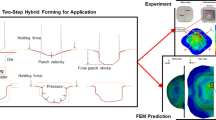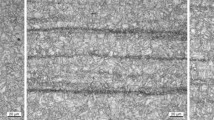Abstract
The hot press bend process of the 5A06 aluminum alloy high-stiffener integral panels was studied by FEM simulations and experiments. The high-temperature deformation behaviors and microstructures were tested by the high-temperature uniaxial tensile tests and the electron backscatter diffraction (EBSD), respectively. A set of physically-based constitutive equations and its VUMAT user subroutine, including dislocation density, grain size, and deformation damage, were established. The effects of forming parameters and blank size on the forming quality of the high-stiffener integral panel were studied. The main typical defects were the surface groove, side face curvature and inclination, springback, and wrinkle of the stiffener. The high-stiffener integral panels should be bent above 350 °C and kept for more than 20 min under a pressure of 8 MPa.



















Similar content being viewed by others
Data availability
Most of the data generated or analyzed during this study are included in this published article; part of the EBSD analysis data used for constitutive equations is available from the corresponding author on reasonable request.
Code availability
The code used to establish the physically-based constitutive equations is not published, but it is available from the corresponding author on reasonable request.
References
Lv Y, Zhang W, Wei Y (2020) The compression properties of the wing integral panel made up of material 7B50-T7751 and 7150-T7751. Int J Lightweight Mater Manuf 3(2):189–192
Zhao C, Li J (2006) Manufacturing technology for fabricating integral panel structure of spacecraft. Aerosp Manuf Technol 8(4):44–48
Zhang XJ, Wang T, Wang JB, Liu C (2017) Analytical modeling of shot peen forming process using cross-sectional linear indentation coverage method. Int J Mech Sci 133:838–845
Miao HY, Demers D, Larose S, Perron C, Lévesque M (2010) Experimental study of shot peening and stress peen forming. J Mater Process Technol 210(15):2089–2102
Luo H, Li W, Li C, Wan M (2017) Investigation of creep-age forming of aluminum lithium alloy stiffened panel with complex structures and variable curvature. Int J Adv Manuf Technol 91:3265–3271
Lam ACL, Shi Z, Yang H, Wan L, Davies CM, Lin J, Zhou S (2015) Creep-age forming AA2219 plates with different stiffener designs and pre-form age conditions: experimental and finite element studies. J Mater Process Technol 219:155–163
Hu W, Wang ZR (2001) Theoretical analysis and experimental study to support the development of a more valuable roll-bending process. Int J Mach Tools Manuf 41(5):731–747
Yan Y, Wang H, Wan M (2011) Prediction of stiffener buckling in press bend forming of integral panels. Trans Nonferrous Metals Soc China 21(11):2459–2465
Liu C, Yue T, Yu X (2019) Springback analysis of the stiffened panel milling from the bent plate. Int J Precis Eng Manuf 20(2):217–232
Chen Y, Zhao S, Wang H, Li J, Hua L (2023) Theoretical analysis and verification on plastic deformation behavior of rocket nozzle using a novel tube upsetting-bulging method. Materials 16(4):1680
Lee M, Kim S, Han HN, Jeong WC (2009) Application of hot press forming process to manufacture an automotive part and its finite element analysis considering phase transformation plasticity. Int J Mech Sci 51(11-12):888–898
Al-Hammadi R, Zhang R, Cui C, Zhou Z, Zhou Y (2023) Superplastic behavior of a Ni-Co-base superalloy with high γ′-phase content. Mater Lett 348:134683
Chang SP, Wang KH, Wang B, Kopec M, Li Z, Wang LL, Liu G (2023) Effects of rapid heating on non-equilibrium microstructure evolution and strengthening mechanisms of titanium alloy. Mater Sci Eng A 880:145337
Zhang P, Zhu L, Luo S, Luo J (2019) Hot stamping forming and finite element simulation of USIBOR1500 high-strength steel. Int J Adv Manuf Technol 103(5-8):3187–3197
Wu Y, Fan RL, Qin ZH, Chen MH (2021) Shape controlling and property optimization of TA32 titanium alloy thin-walled part prepared by hot forming. Trans Nonferrous Metals Soc China 31(8):2336–2357
Chen C, Chen M, Xie L, Gong Z, Ye J (2019) Numerical and experimental investigations of the hot stamping process for complex aircraft skin parts composed of TA32 high-temperature titanium alloy using an Arrhenius-type constitutive model. Int J Adv Manuf Technol 103(1-4):807–817
Wang A, Zhong K, El Fakir O, Liu J, Sun C, Wang L, Lin J, Dean TA (2017) Springback analysis of AA5754 after hot stamping: experiments and FE modelling. Int J Adv Manuf Technol 89(5-8):1339–1352
Xiao W, Wang B, Wu Y, Yang X (2018) Constitutive modeling of flow behavior and microstructure evolution of AA7075 in hot tensile deformation. Mater Sci Eng A 712:704–713
Garrett RP, Lin J, Dean TA (2005) An investigation of the effects of solution heat treatment on mechanical properties for AA 6xxx alloys: experimentation and modelling. Int J Plast 21(8):1640–1657
Wu Y, Wang D, Liu Z, Liu G (2019) A unified internal state variable material model for Ti2AlNb-alloy and its applications in hot gas forming. Int J Mech Sci 164:105126
Alabort E, Putman D, Reed RC (2015) Superplasticity in Ti–6Al–4V: characterisation, modelling and applications. Acta Mater 95:428–442
Li Y, Yu L, Zheng J, Guan B, Zheng K (2021) A physical-based unified constitutive model of AA7075 for a novel hot forming condition with pre-cooling. J Alloys Compd 876:160142
Zheng K, Dong Y, Zheng D, Lin J, Dean T (2019) An experimental investigation on the deformation and post-formed strength of heat-treatable aluminium alloys using different elevated temperature forming processes. J Mater Process Technol 268:87–96
Fan R, Wu Y, Chen M, Wu D, Wu T (2023) Determining the hot forming limits of titanium alloy sheet under different strain paths by constant equivalent strain rate hot gas bulging tests. J Mater Process Technol 319:118067
Tang B, Li H, Guo N, Zhang H, Liu G, Li X, Zuo Y (2021) Revealing ductile/quasi-cleavage fracture and DRX-affected grain size evolution of AA7075 alloy during hot stamping process. Int J Mech Sci 212:106843
Fan XB, Yuan SJ (2022) Innovation for forming aluminum alloy thin shells at ultra-low temperature by the dual enhancement effect. Int J Extrem Manuf 4:033001
Wang P, Wan G, Jin J, Wang Y, Xiang N, Zhao X, Zhao X, Yuan B, Wang Z (2022) Subregional flexible-die control in magnetorheological pressure forming. J Mater Process Technol 307:117698
Huo Y, Bai Q, Wang B, Lin J, Zhou J (2015) A new application of unified constitutive equations for cross wedge rolling of a high-speed railway axle steel. J Mater Process Technol 223:274–283
Lin J, Liu Y, Farrugia D, Zhou M (2005) Development of dislocation-based unified material model for simulating microstructure evolution in multi-pass hot rolling. Philos Mag 85:1967–1987
Acknowledgements
The authors gratefully acknowledge the financial support from the National Natural Science Foundation of China (grant no. 51805256).
Funding
This research was funded by the National Natural Science Foundation of China (grant no. 51805256).
Author information
Authors and Affiliations
Contributions
YW contributed to the conception of the study, the constitutive equations, and part of the manuscript.
XZ contributed to the simulation analysis and wrote the manuscript.
DW performed the experiment and analyzed the experiment data.
ZQ performed the material tensile test and analyzed the data.
BL performed the EBSD analysis and prepared the data.
Corresponding author
Ethics declarations
Ethics approval
Not applicable.
Consent to participate
Not applicable.
Consent for publication
Not applicable.
Competing interests
The authors declare no competing interests.
Additional information
Publisher’s note
Springer Nature remains neutral with regard to jurisdictional claims in published maps and institutional affiliations.
Rights and permissions
Springer Nature or its licensor (e.g. a society or other partner) holds exclusive rights to this article under a publishing agreement with the author(s) or other rightsholder(s); author self-archiving of the accepted manuscript version of this article is solely governed by the terms of such publishing agreement and applicable law.
About this article
Cite this article
Wu, Y., Zhou, X., Wu, D. et al. Hot-press bending technology of the 5A06 alloy high-stiffener integral panel: constitutive equation, simulation, and experiment. Int J Adv Manuf Technol 129, 2537–2550 (2023). https://doi.org/10.1007/s00170-023-12485-9
Received:
Accepted:
Published:
Issue Date:
DOI: https://doi.org/10.1007/s00170-023-12485-9




